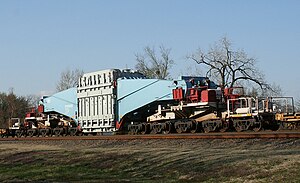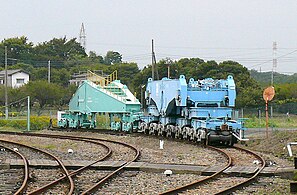| This article includes a list of general references, but it lacks sufficient corresponding inline citations. Please help to improve this article by introducing more precise citations. (May 2015) (Learn how and when to remove this message) |

A Schnabel car or Schnabel wagon is a specialized type of railroad freight car. It is designed to carry heavy and oversized loads in such a way that the load makes up part of the car. The load is suspended between the two ends of the cars by lifting arms; the lifting arms are connected to an assembly of span bolsters that distribute the weight of the load and the lifting arm over many wheels.
When a Schnabel car is empty, the two lifting arms are connected to one another and the car can usually operate at normal freight train speeds. Some Schnabel cars include hydraulic equipment that will either lift or horizontally shift the load while in transit (at very low speeds) to clear obstructions along the car's route. As of 2012, there were 31 Schnabel cars operating in Europe, 30 in North America, 25 in Asia, and one in Australia.
Design

A: Not self-supporting with low-loading bridge
B: Self-supporting load
C: Not self-supporting with through-loading bridge
The largest Schnabel car in public railroads operation, reporting number WECX 801, was completed in 2012 by Kasgro Railcar for Westinghouse Nuclear and is used in North America primarily to transport reactor containment vessels. It has 36 axles (18 for each half). Each half contains nine trucks which are connected by a complex system of span bolsters. Its tare (unloaded) weight is 399.6 short tons (362.5 t; 356.8 long tons) and has a load limit of 1,017.9 short tons (923.4 t; 908.8 long tons) for a maximum gross weight of 1,417.5 short tons (1,285.9 t; 1,265.6 long tons). WECX 801 has the ability to shift its load 44 inches (112 cm) vertically and up to 40 inches (102 cm) laterally on either side of the car's center line. When empty, this car measures 231 ft (70 m) long; for comparison, a conventional boxcar currently operating on North American railroads has a single two-axle truck at each end of the car, measures 50 to 89 feet (15.24 to 27.13 m) long and has a capacity of 70 to 105 short tons (64 to 95 t; 63 to 94 long tons). The train's speed is limited to 25 mph (40 km/h) when WECX 801 is empty, but only 15 mph (24 km/h) when loaded, and the system requires a crew of six operators in addition to the train's crew.
The second largest Schnabel car in service, owned by ABB, bears the CEBX 800 registration, and is used in North America. Built by Krupp AG, it has 36 axles (18 for each half). Each half has 9 bogies linked together by a complex system of span bolsters. Its tare weight (empty mass) is 370 tonnes (360 long tons; 410 short tons). When empty, this wagon is 70.6 m (232 ft) long. It can carry a load of 34.5 m (113 ft) long and 852.3 tonnes (838.8 long tons; 939.5 short tons). By comparison, a classic boxcar has only one bogie with two axles at each end, is about 15 meters (49 ft) long and carries a load that does not exceed 80 tonnes (79 long tons; 88 short tons).
History

The word Schnabel is from German Tragschnabelwagen, meaning "carrying-beak-wagon", because of the usually tapered shape of the lifting arms, resembling a bird's beak.
In World War II the German Wehrmacht used Schnabel cars for transporting the Karl-Gerät heavy-calibre (54 cm and 60 cm calibre) siege mortars. These were self-propelled with a continuous-track suspension chassis of substantial length to maneuver into a firing position over a short range, but depended on a pair of purpose-designed Schnabel cars for long-range transport by rail. The same system was also used at the same time for the rail transport of the French FCM 2C super-heavy armoured fighting vehicle.
In the United States, the first Schnabel car, WECX 200, was built for Westinghouse Nuclear by manufacturer Greenville Steel Car in the 1960s.
List of selected Schnabel wagons
| Class number | Maximum carrying capacity | Tare weight | Wheelsets | Quantity (DB as at 31 Dec 1997) |
Length over buffers | Bogie pivot spacing or wheelset spacing |
Length of low loading bay |
|---|---|---|---|---|---|---|---|
| Uaai 812 | 159 t (156 long tons; 175 short tons) |
41,000 kg 90,000 lb |
10 | 1 | 19,704 mm 64 ft 7+3⁄4 in |
8,970 mm 29 ft 5+1⁄8 in |
N/A |
| Uaai 820 | 157 t (155 long tons; 173 short tons) |
83,100 kg 183,200 lb |
12 | 1 | 31,440 mm 103 ft 1+3⁄4 in |
19,100 mm 62 ft 8 in |
8,500 mm 27 ft 10+5⁄8 in |
| Uaai 821 | 190 t (190 long tons; 210 short tons) (180 t (180 long tons; 200 short tons) with suspension bars) |
83,800 kg 184,700 lb |
12 | 1 | 30,124 mm 98 ft 10 in |
19,100 mm 62 ft 8 in |
8,000 mm 26 ft 3 in |
| Uaai 823 | 230 t (230 long tons; 250 short tons) |
102.2 t 100.6 long tons; 112.7 short tons |
16 | 1 | 37,080 mm 121 ft 7+7⁄8 in |
N/A | N/A |
| Uaai 831 | 275 t (271 long tons; 303 short tons) (250 t (250 long tons; 280 short tons) with suspension bars) |
170,000 kg 370,000 lb |
20 | 2 | 45,120 mm 148 ft 3⁄8 in |
18,730 mm 61 ft 5+3⁄8 in 28,330 mm 92 ft 11+3⁄8 in |
N/A |
| Uaai 836 | 317 t (312 long tons; 349 short tons) |
82.870 kg 182.70 lb |
20 | 1 | 31,800 mm 104 ft 4 in |
15,300 mm 50 ft 2+3⁄8 in |
N/A |
| Uaai 837 | 398 t (392 long tons; 439 short tons) |
N/A | 24 | 1 | N/A | N/A | N/A |
| Uaai 838 (313 t (308 long tons; 345 short tons) with suspension bars) |
N/A | 341 t (336 long tons; 376 short tons) |
24 | 1 | N/A | N/A | N/A |
| Uaai 839 | 454 t (447 long tons; 500 short tons) |
N/A | 32 | 1 | N/A | N/A | N/A |
Gallery
- Examples of Schnabel cars
-
 ÖBB Schnabel car with an electrical transformer near Koblenz in May 2009
ÖBB Schnabel car with an electrical transformer near Koblenz in May 2009
-
 Two Schnabel cars without loads in Japan
Two Schnabel cars without loads in Japan
-
 Empty Japanese wagon
Empty Japanese wagon
-
 Many wheels of a German schnabel wagon
Many wheels of a German schnabel wagon
-
 Arrival of a Schnabel wagon at its destination with a large transformer. The load will now be transported by road on a lowboy.
Arrival of a Schnabel wagon at its destination with a large transformer. The load will now be transported by road on a lowboy.
-
 Onward transportation of the large transformer by road to the electricity substation
Onward transportation of the large transformer by road to the electricity substation
-
 Russian Zh. D. railway gun at Krasnaya Gorka fort
Russian Zh. D. railway gun at Krasnaya Gorka fort
-
 US patent image
US patent image
See also
References
- ^ Vantuono, William C. (June 14, 2012). "Kasgro builds "World's Largest Railroad Car"". Railway Age. Retrieved December 29, 2021.
- "WECX 801". southern.railfan.net. Retrieved February 9, 2016.
- Tom Daspit, CEBX 800 read (Retrieved 2010-01-22).
- Jentz, Thomas (2001). Bertha's Big Brother: Karl-Geraet (60 cm & 54 cm). Panzer Tracts. pp. 8, 19. ISBN 0-9708407-2-1.
- Uaai 812
- Uaai 812
- Uaai 820
- Uaai 821
- Uaai 823
- Uaai 831
- Uaai 836
- Uaai 837
- Uaai 838
- uaai-839
- https://patents.google.com/patent/US4041879A, filed December 1, 1975, issued to Charles R. Cockrell, with Combustion Engineering, Inc. as assignee, now expired.
Further reading
- Daspit, Tom (2005). "CEBX 800". Retrieved May 6, 2005. (additional technical details on CEBX 800)
- GATX Corporation (2005). "Car types". Archived from the original on May 7, 2005. Retrieved May 6, 2005. (boxcar comparison figures)
- Passi, Peter (May 5, 2005). "Railroad Giant". Duluth News Tribune. Archived from the original on May 6, 2005. Retrieved May 6, 2005. (details on CEBX 800)
- Railway Industrial Clearance Association (2000). "Glossary of terms used in railroad high and wide clearances". Archived from the original on June 13, 2005. Retrieved May 6, 2005. (basic definition of a Schnabel car)
External links
- Schnabel cars – photos and technical information on Schnabel cars used worldwide.
- Heavy Rail Transport Basics
| Rail transport freight rolling stock | |
|---|---|
| Enclosed equipment | |
| Open equipment |
|
| Non-revenue equipment | |